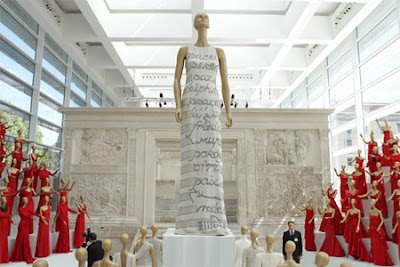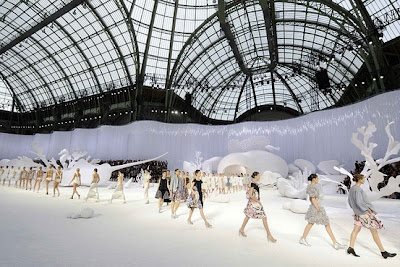If we think about European
fashion, obviously the Italians and the French stand out: Armani, Chanel,
Dior, Dolce & Gabbana, Fendi,
Ferragamo, Gucci, Hermes, Louis Vuitton, Prada, Valentino, Yves Saint
Laurent and so on. They are the best in the world, with their detail to design,
craftsmanship, textiles, leathers and style. It is this last detail that I
would like to explore. The diversity of each country’s style seen through key
fashion elements; the cultural significance and what the word ‘Style’ means to
each person. Let’s start with Italy. When we think of Italian fashion,
handbags, shoes, leather and the words bold and elegant come to mind. The
Italians would give their soul for the latest IN bag, coat or pair of shoes.
One can have a good heart and soul, but that’s worth nothing if you don’t have
an impeccable sense of style, the right hairstyle and make a fantastic fashion
statement. Roman and Milanese women for example strut the streets of their
cities with utter self- confidence and elegance; just watching them make their way through the Galleria or
crowded Via dei Condotti, walking into Prada
or Valentino and carefully eyeing every item in the store, you realise
they have almost as much pleasure as actually buying something in the store!
The Italiane always and I mean ALWAYS, match. Everything they wear goes with
everything. The shoes, the belt, the bag go together perfectly. Their make- up
and hair style also tie in. They never mismatch colours and have something that
distinguishes one designer from another.
Having briefly outlined the epitome of the Italian persona when it comes
to fashion, let’s look at a couple of Italian fashion houses, which is where it
all started.
Gucci: First opened in
Florence in 1921 by Guccio Gucci (Poor man, what parents would do that?), and
today has a revenue of 4.2 Billion.
Artistic Directors Tom Ford, and currently Frida Giannini have flourished under Gucci, modelling its style to what it is today. Gucci, famous for its double ‘G’s’ and green and red stripes, is a Must in an Italian’s wardrobe-starting with the ‘Jackie O’ bag. The fashion house, is known for its craftsmanship in leather so the shoes and bags make me (Italian raised) salivate whenever I see one!
Artistic Directors Tom Ford, and currently Frida Giannini have flourished under Gucci, modelling its style to what it is today. Gucci, famous for its double ‘G’s’ and green and red stripes, is a Must in an Italian’s wardrobe-starting with the ‘Jackie O’ bag. The fashion house, is known for its craftsmanship in leather so the shoes and bags make me (Italian raised) salivate whenever I see one!
Then there is Valentino: Valentino Garavani
started designing in Paris under
Jacques Fath,
afterwards he moved on to Balenciaga, Jean Desses and Guy Laroche. He moved
back to Rome in 1959 and opened his first store on Via dei Condotti, which has
been there ever since. By the mid 1960’s he was considered the Italian fashion
Maestro, won the Neiman Marcus Fashion Award (The fashion equivalent of the
Oscars) and had A list clients such as Elizabeth Taylor, Audrey Hepburn and
Jacqueline Onassis.
Valentino
went on to open stores world- wide and continued designing his famous ‘red
dresses’. He retired in January 2008, leaving the role of creative director
divided between Maria Grazia Chiuri and Pier Paolo Piccioli but not before
showing his entire collections at the ‘Museo dell’Ara Pacis’ in Rome in 2007.
The exhibition brought fashionistas from all over the world (myself included)!
It was amazing - every beautiful item he had ever created was in the one
building! And once again, as a properly trained Italianised woman, I found
myself gasping in awe at the beauty and intricacy! The Italian way of life
revolves around s
France…Paris…Yves Saint Laurent… Hermes (and
Birkin bags).…Louis Vuitton….Les Champs Elysees.. Rue du Faubourg
Saint-Honoré….. Rue Saint-Honoré.….Chanel …more Birkin bags!! The more I think
about it, the more I yearn for Paris and realise I am thousands of kilometres
away. When it comes
to fashion, the French think they are superior, even more than the Italians do.
They just put this with that, whether it be a pair of Louboutins with jeans and
a Bulgari necklace and off they go. They have an innate sense of style which is
quite different to the Italians. While I was living there, I found myself on
numerous occasions being gobsmacked by snooty Parisian women walking into
Hermes, and then walking back out with not one, not two, but
THREE birkin
bags, and at 20k each (and a waiting
list of months), who could keep up? (The Birkin bag is handmade in leather by
Hermès and named after actress and singer Jane Birkin. The bag is a symbol of
wealth due to its high price and elusiveness to the public. Its prices range
from $9,000 to $150,000 (being the red croc one). Costs escalate according to
the materials. The bags are distributed to Hermès boutiques on unpredictable
schedules and in limited quantities, creating scarcity and exclusivity.
They could easily then go
straight into Adidas and buy a pair of joggers, which obviously they would wear
with the Birkin. (And as a true Italian, the words- ‘What on earth ???’ come to
mind) but they would pull it off and look smashing. Their sense of style is so
different to the Italian…perhaps, generally a little more reserved, not as bold
but, it works well for them! From A to Z they will have it all, even if they
can’t eat for the rest of their (stick thin but healthy) lives. Moving on, (sense tone of envy), let’s
consider the French classic fashion house, Chanel, from early days to modern
times (even in Italian eyes the top French houses are considered places of
worship).
The absolute classic – Chanel – Gabrielle
‘Coco’ Chanel changed the world view
of modern fashion for women. She began in 1909, opening a shop on the
ground floor of Etienne Balsan’s apartment in Paris. His home was a meeting
place for the hunting elite of France and the gentlemen would bring their
fashionable mistresses along, giving Chanel an opportunity to sell decorated
hats. During this time she had a good friendship with Arthur Capel, a member of
the hunting society. He saw a business woman in CoCo, and helped her buy the
legendary location of 31 Rue Cambon in Paris in 1910.
His arrival at Chanel was
drastic. He changed the older lines to shorter cuts and eye capturing designs.Today,
Lagerfeld still leads the empire, creating the most amazing fashion shows in
the Grand Palais of Paris (another reason why the French think they are the
top). Every season he creates byzantine palaces, alien landscapes, plane
flights and ‘under the sea’ themes.


















